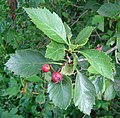| Crataegus erythropoda | |
|---|---|
 | |
| Scientific classification | |
| Kingdom: | Plantae |
| Clade: | Tracheophytes |
| Clade: | Angiosperms |
| Clade: | Eudicots |
| Clade: | Rosids |
| Order: | Rosales |
| Family: | Rosaceae |
| Genus: | Crataegus |
| Section: | Crataegus sect. Douglasia |
| Series: | Crataegus ser. Cerrones |
| Species: | C. erythropoda |
| Binomial name | |
| Crataegus erythropoda | |
 | |
| Natural range of Crataegus erythropoda | |
| Synonyms | |
Crataegus erythropoda is a hawthorn native to the southern Rocky Mountains in the United States. The leaves are conspicuously shiny above and fruit ("haws") are dark purplish red. [2] It is seldom cultivated, but at one time was listed in the nursery trade under the common name "Chocolate Haw". [3] It is closely related to C. rivularis which has fruit that are fully black when ripe. [4] [5]


